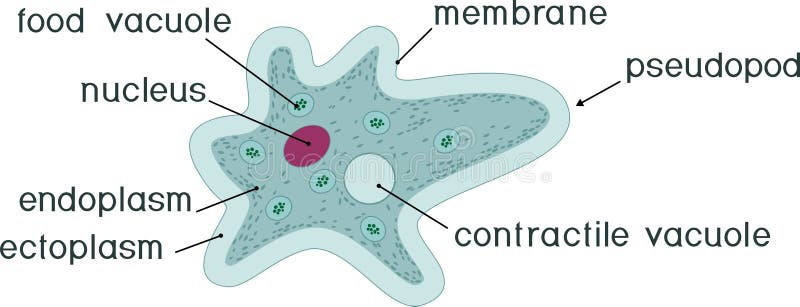Please help me on this project on Amoeba.I have been trying to get done with it for some weeks now but i don’t seem to be making any progress, I will love it if anyone can explain any of the below taglines. thanks alot
- amoeba proteus common name
- amoeba proteus kingdom
- amoeba proteus family
- amoeba proteus order
- amoeba proteus disease
- amoeba proteus life cycle
- BY THE WAY; AMOEBA IS NOT A BACTERIA
- IT IS A UNICELLULAR PROTOZOAN
- THEY ARE HETEROTROPHS THAT INGESTS FOOD BY A PROCESS CALLED ENDOCYTOSIS
- SOME SPECIES OF AMOEBA E.G N. fowleri amoeba COULD BE HARMFUL TO HUMANS
- THE FAMILY OF AMOEBA IS Amoebidae
Amoeba proteus is a one-celled animal about 25 mm ( 1/100 inch) in diameter, and is, therefore, invisible to the naked eye. Under the compound microscope it appears as an irregular colorless particle of animated jelly which is constantly changing its shape by thrusting out finger-like processes.
- Habitat of Amoeba proteus. – Amoeba proteus lives in fresh-water ponds and streams. It may be obtained for laboratory use from a variety of places, such as the organic ooze from decaying vegetation or the lower surface of lily pads. About two weeks before the specimens are needed, a mass of pond weed (Ceratophyllum is the best) should be gathered, placed in flat dishes, and immersed in water. The vegetation soon decays, and a brown scum appears on the surface.
In this scum amoebae may be found.
The fact that amoebae appear in large numbers in cultures, such as just described, indicates that decaying pond weed furnishes a good habitat for them. Here they find their food, which consists of small aquatic plants, such as Oscillaria and diatoms, other protozoa, bacteria, and other animal and vegetable matter. While looking for an amoeba note the character of its habitat - General morphology – Two regions are distinguishable in the body of amoeba, – an outer colorless layer of clear cytoplasm,the ectosarc, consisting of ectoplasm, and a comparatively large central mass of granular cytoplasm, the endosarc, consisting of
endoplasm. A single clear spherical body, usually lying near the end of the animal away from the direction of motion, and disappearing at more or less regular intervals; is the contractile vacuole.
Suspended in the endosarc is a nucleus, usually one or more food. vacuoles, material ready for excretion. foreign substances such as grains of sand, and undigested particles, the amount of the latter depending upon the feeding activity of the specimen at the time
when examined.
From this description it will be noted that Amoeba proteus contains all of the essential constituents of a cell. It is, moreover,simple in structure, shows a number of physiological activities in their simplest form, is one of the most primitive of all animals and is easily obtained. For these reasons it has been, and still is, a favorite animal for investigation. - Cytology. – The ectoplasm is easily distinguished from the endoplasm because of the absence within it of granules. It is finner than the endoplasm.
The endoplasm occupies the central portion of the body. Being less dense than the ectoplasm, it contains within it all of the large granUles. No fixed line of separation between it and the ectoplasm is visible.
The nucleus is not easily seen in living specimens. In animals that have been properly killed and stained it appears as a biconcave disk in young specimens but is often folded and convoluted in older specimens. Its position in the endoplasm is not definite, but
changes during the movements of the amoeba. It has a firm membrane and contains a great many spherical particles of chromatin scattered about in the nuclear sap. During the life of an amoeba, before the period of reproduction, the nucleus plays an important
role in the metabolic activity of the cell. This has been proved by experiments in which the animal was cut in two. The streaming of the cytoplasm ceases within a few minutes in the piece without a nucleus but is resumed after a few hours. The enucleated amoeba
may attach itself to the substratum and exhibits irritability although its responses to stimuli are modified. Food bodies are engulfed and digested in apparently a normal manner but death finally ensues. The part with the nucleus continues its life as a normal amoeba. Profound changes in the nucleus take place during reproduction. - DESCRIBE BINARY FISSION IN AMOEBA
- CHARACTERISTICS OF PHYLUM PROTOZOA
DIAGRAMS OF AMOEBA PROTEUS


